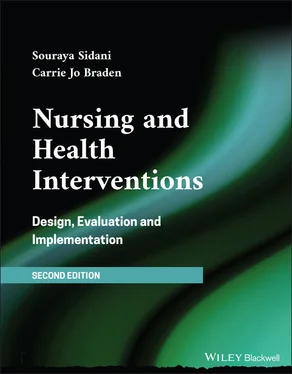4 Bootzin, R.R. & Epstein, D.R. (2011) Understanding and treating insomnia. Annual Review of Clinical Psychology, 7, 435–458.
5 Buscail, C., Menai, M., Salanave, B., et al. (2016) Promoting physical activity in a low‐income neighborhood of the Paris suburb of Saint‐Denis: Effects of a community‐based intervention to increase physical activity. BMC Public Health, 16, 667–675.
6 Cambon, L., Terral, P., & Alla, F. (2019) From intervention to interventional system: Towards greater theorization in population health intervention research. BMC Public Health, 19, 389–345.
7 Carey, R.N., Connell, L.E., Johnston, M., et al. (2018) Behavior change techniques and their mechanisms of action: A synthesis of links described in published intervention literature. Annals of Behavioral Medicine, 53(8), 693–707.
8 Cutrona, S., Choudhry, N., Fisher, M., et al. (2010) Modes of delivery for interventions to improve cardiovascular medication adherence: Review. American Journal of Managed Care, 16(12), 929–942.
9 Dombrowski, S.U., O'Carroll, R.E., & Williams, B. (2016) Form of delivery as a key “active ingredient” in behavior change interventions. British Journal of Health Psychology, 21, 733–740.
10 Forbes, A. (2009) Clinical intervention research in nursing. International Journal of Nursing Studies, 46(4), 557–568.
11 Grove, S.K., Gray, J.R., & Burns, N. (2015) Understanding Nursing Research: Building an Evidence‐Based Practice (6th Ed). Elsevier, St. Louis, Missouri.
12 Harvey, A.G., Sharpley, A.L., Ree, M.J., et al. (2007) An open trial of cognitive therapy for chronic insomnia. Behavior Research and Therapy, 45(10), 2491–2501.
13 Holmqvist, M., Vincent, N., & Walsh, K. (2014) Web‐ vs telehealth‐based delivery of cognitive behavioral therapy for insomnia: A randomized controlled trial. Sleep Medicine, 15, 187–195.
14 Kühne, F., Ehmcke, R., Härter, M., et al. (2015) Conceptual decomposition of complex health care interventions for evidence synthesis: A literature review. Journal of Evaluation in Clinical Practice, 21, 817–823.
15 Mannion, R. & Exworthy, M. (2017) (Re) making the proscrustean bed? Standardization and customization as competing logics in healthcare. International Journal of Health Policy and Management, 6(6), 301–304.
16 Markle‐Reid, M., Valaitis, R., Bartholomew, A., et al. (2019) Feasibility and preliminary effects of an integrated hospital‐to‐home transition care intervention for older adults with stroke and multimorbidity : A study protocol. Journal of Comorbidity, 9, 1–22.
17 Mayne, J. (2015) Useful theory of change models. The Canadian Journal of Program Evaluation, 30(2), 119–142.
18 Michie, S., Fixsen, D., Grimshaw, J.M., & Eccles, M.P. (2009) Editorial. Specifying and reporting complex behavior change interventions: The need for a scientific method. Implementation Science, 4, 40–45.
19 Moore, G.F. & Evans, R.E. (2017) What theory, for whom and in which context? Reflections on the application of theory in the development and evaluation of complex population health intervention. SSM—Population Health, 3, 132–135.
20 Moore, G.F., Evans, R.E., Hawkins, J., et al. (2019) From complex social interventions to interventions in complex social systems: Future directions and unresolved questions for intervention development and evaluation. Evaluation, 25(1), 23–45.
21 Sidani, S., Epstein, D.R., & Fox, M. (2019) Comparing the effects of single and multiple component therapies for insomnia on sleep outcomes. Worldviews on Evidence‐Based Nursing, 16(3), 195–203.
22 Sidani, S., El‐Masri, M., & Fox, M.T. (2020) Guidance for the reporting of an interventions theory. Research and Theory for Nursing Practice, 34(1), 35–48.
23 Wight, D., Wimbush, E., Jepson, R., & Doi, L. (2015) Six steps in quality intervention development (6SQuID). Journal of Epidemiology and Community Health, 70, 520–525.
SECTION II DEVELOPING INTERVENTIONS
CHAPTER 3 Understanding Health Problems
Poorly designed interventions can waste resources (Moore et al., 2019): Despite the effort expanded by health professionals and clients in carrying them out, the interventions are not useful in preventing, managing, or resolving the health problem. Therefore, it is essential to carefully design health interventions in order to improve their success in addressing the health problem.
The process for designing or developing health interventions is systematic and rigorous. It involves critical analysis and thorough application of relevant approaches and methods to gain a lucid understanding of the health problem requiring remediation, which is represented in the theory of the problem ( Chapter 3). This understanding informs the specification of the intervention's elements, which is represented in the implementation theory, and the delineation of the mechanism underlying the intervention's effects on the outcomes, which is reflected in the theory of change ( Chapter 4). The process culminates in the generation of the intervention theory ( Chapter 5) that guides the delivery and evaluation of the intervention.
The development of a thorough and comprehensive understanding of the health problem requiring remediation is foundational for designing interventions (Bleijenberg et al., 2018; Wight et al., 2016). The understanding entails clarification of what the problem is, how it is experienced, by what population and in what context (Aráujo‐Soares et al., 2018). Different approaches and methods can be utilized to gain an understanding of the problem; using a combination of approaches and methods is recommended to iteratively delineate the theory of the problem that is well grounded in pertinent theory, supported by evidence, and reflective of the target client population's experience and context.
In this chapter, the importance of understanding the health problem, captured in the theory of the problem, is explained. The elements of the theory are identified and illustrated with examples. The theoretical, empirical, and experiential approaches, and their respective methods, for developing the theory of the problem are discussed.
3.1 IMPORTANCE OF UNDERSTANDING HEALTH PROBLEMS
The terms health problem, diagnosis, and need are often used (in different health‐related discipline or professions) interchangeably to reflect a situation requiring a solution. Clients (individuals, families, communities) experience a range of health problems and seek health professionals' assistance in selecting and applying appropriate interventions to address the problems. Health problems are the triggers for designing interventions since remedying the problem requires understanding it first (Kok et al., 2016). Poor conceptualization of the problem could result in the design of inappropriate and potentially ineffective intervention, that is, type III error (Renger, 2011). Accordingly, understanding the health problem requiring remediation provides directions for: specifying the goals of the intervention; identifying its active ingredients that are expected to successfully address the problem; and delineating contextual factors that should be considered in operationalizing and providing an intervention. Interventions designed in a way that is responsive to the target client populations' experience of the health problem and context are likely to be acceptable, efficient, and effective (Huntink et al., 2014; Yardley et al., 2015). For instance, Glanz and Bishop (2010) stated that the most successful public health interventions are based on an understanding of health behaviors and the contexts in which they occur. The understanding is best represented in the theory of the problem.
3.2 THEORY OF THE PROBLEM
The theory of the problem is also called logic model of the problem (Dalager et al., 2019). It presents a systematic articulation of the health problem requiring remediation. Health problems are experienced in different domains of health, in different ways, by different clients presenting with different personal and health profiles. The problems are brought about, caused, or influenced by a range of factors operating at different levels, in different contexts. This heterogeneity or variation in experience demands a clarification of the health problem as encountered in the clients' circumstances or contexts (Butner et al., 2015; Leask et al., 2019). The theory of the problem is a middle range theory that provides a comprehensive conceptualization of the health problem requiring remediation. The theory defines the problem, identifies influential factors, and explains the relationships among them, that is, how the factors contribute to the problem. The theory can also specify possible consequences if the problem is not addressed.
Читать дальше












